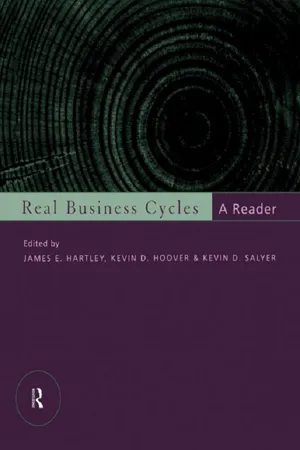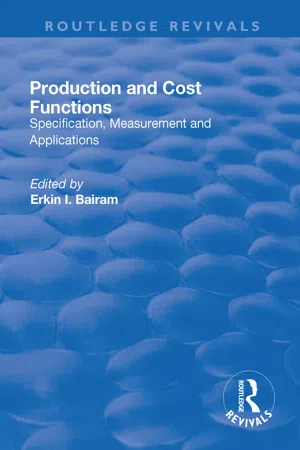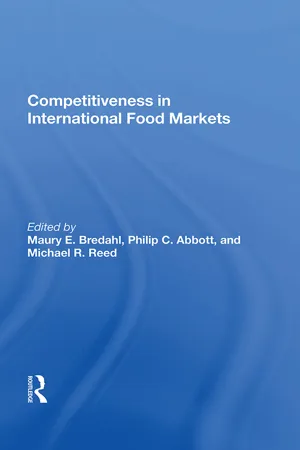Economics
Aggregate Production Function
The aggregate production function represents the relationship between the total output of an economy and the inputs used in production, such as labor and capital. It is a key concept in macroeconomics and is used to analyze the overall productivity and efficiency of an economy. The aggregate production function helps economists understand the factors that contribute to economic growth and development.
Written by Perlego with AI-assistance
Related key terms
8 Key excerpts on "Aggregate Production Function"
- eBook - ePub
Intermediate Microeconomics: Neoclassical and Factually-oriented Models
Neoclassical and Factually-oriented Models
- Lester O. Bumas(Author)
- 2015(Publication Date)
- Routledge(Publisher)
CHAPTER FIVEThe Production Function, Productivity, and Productivity GrowthThe production function relates the rate of production to the state of technology and the employment of the factors of production. It is arguably the most important function in the neoclassical paradigm because: (1) It is the basis of the cost functions. (2) Its slope, the marginal productivity function, is the foundation of the factor demand functions. (3) And with factor supplies given, marginal productivity functions yield the distribution of income to the factors of production.In a general sense, the production function represents very practical and well-known relationships implicit in all employment change decisions made by managers to vary the rate of production.The analysis used in the area of production closely parallels that used in the basic neoclassical models of consumer behavior. Marginal productivity analysis, to be used here, is very much like marginal utility analysis previously covered. The same is true of the close relationship between the isoquant analysis of this chapter and the previously presented indifference curve analysis.Finally, an increasing standard of living, a common aspiration in acquisitive societies, essentially requires advances in technology and productivity, which shifts the production function.The Production Function
The production function is defined as follows:The production function relates the maximum rate of production possible, Q , to the employment of the factors of production—labor, L , and capital, K —at a given level of technology, T : Q = f(T; L,K) .Why the omission of the third factor of production, land or natural resources? The answer rests on David Ricardo’s definition of land as “the original and indestructible powers of the soil.” Once a unit of land is worked on by labor or capital, it is no longer in its original or natural state. This transforms land into capital, the produced means of production. There is, however, no law against breaking capital down into categories, one or more of which could be land or closely related to land. Thus, a not uncommon form of the production function has the rate of production as a function of the employment of labor, L ; capital in the form of facilities and equipments, K ; and materials purchased from other producers, M : Q =f(T; L,K,M) . The omission of the level of technology, T - eBook - ePub
Real Business Cycles
A Reader
- James Hartley, Kevin Hoover, Kevin D. Salyer(Authors)
- 2013(Publication Date)
- Routledge(Publisher)
The Solow residualPassage contains an image
Chapter 27Technical Change and the Aggregate Production Function*
Review of Economics and Statistics Robert M. SolowIn this day of rationally designed econometric studies and super-input-output tables, it takes something more than the usual “willing suspension of disbelief” to talk seriously of Aggregate Production Function. But the Aggregate Production Function is only a little less legitimate a concept than, say, the aggregate consumption function, and for some kinds of long-run macro-models it is almost as indispensable as the latter is for the short-run. As long as we insist on practicing macro-economics we shall nped aggregate relationships.Even so, there would hardly be any justification for returning to this old-fashioned topic if I had no novelty to suggest. The new wrinkle I want to describe is an elementary way of segregating variations in output per head due to technical change from those due to changes in the availability of capital per head. Naturally, every additional bit of information has its price. In this case the price consists of one new required time series, the share of labor or property in total income, and one new assumption, that factors are paid their marginal products. Since the former is probably more respectable than the other data I shall use, and since the latter is an assumption often made, the price may not be unreasonably high.Before going on, let me be explicit that I would not try to justify what follows by calling on fancy theorems on aggregation and index numbers.1 Either this kind of aggregate economics appeals or it doesn’t. Personally I belong to both schools. If it does, I think one can draw some crude but useful conclusions from the results.Theoretical Basis
I will first explain what I have in mind mathematically and then give a diagrammatic exposition. In this case the mathematics seems simpler. If Q represents output and K and L - eBook - ePub
- Enrico Colombatto(Author)
- 2016(Publication Date)
- Routledge(Publisher)
3 The economics of production and growthDOI: 10.4324/9781315658988-43.1 What can the economics of production tell us?
The relationship between the economics profession and the analysis of production is mixed. On the one hand, economists are attracted by production because it is conceptually simple, does not involve subjective judgements, and provides plenty of opportunities to engage in measurement. In particular, the economist of production observes prices of inputs and outputs, and selects the appropriate techniques to minimise costs and meet consumers’ preferences. Yet, he feels ill at ease when he tries to model how production develops, better technologies come to the surface and progress, new products are conceived, know-how is acquired, people interact and organisations evolve. Ideally, the economist would like to deal with a ‘typical’ firm, and then refer to real firms as specific examples of the typical firms. Yet, the typical firm exists even less than the typical consumer, and theorising becomes a daunting exercise.Not surprisingly, the economics profession has in fact restrained its ambitions, and inclined to engage in attempts to enhance our understanding of the production process by categorising the various phenomena involved. In this chapter, therefore, we shall clarify the main concepts that have become familiar in everyday economic parlance (sections 3.2–3.4), delve into the relationship between the economics of production and the life of firms (sections 3.5–3.7) and conclude by commenting on the consequences for growth (section 3.8).3.2 Production functions, technologies and productivity
The basic working tool of production economics is the so-called ‘production function’, which shows how inputs are employed and generate output, subject to an efficiency constraint. Efficiency means that the agent succeeds in producing the maximum possible amount of output, given a set of inputs; or in using the minimum amount of inputs, given an output target. In other words, efficient production means no wastages. Economists describe all this in terms of ‘techniques’ and ‘technologies’. The term ‘technique’ illustrates how inputs can be mixed and transformed into output. For example, a producer can use technique T1 and produce one unit of output with three units of labour and two units of capital; or technique T2 and produce one unit of output with seven units of labour and one unit of capital, or technique T3 and produce one unit of output with nine units of labour and two units of capital (note that T3 is inefficient, since T1 and T2 - eBook - ePub
Production and Cost Functions: Specification, Measurement and Applications
Specification, Measurement and Applications
- Erkin Bairam(Author)
- 2018(Publication Date)
- Routledge(Publisher)
This chapter considers the accounting problems of describing and measuring production, cost and profit functions in practice and the implications of this for economic theory and the econometric estimation of these functions and other related matters. Many economists and econometricians tend to interpret the financial data provided by accountants from the viewpoint of neo-classical economic theory. Due to the difficulties associated with operationalising this theoretical approach significant problems arise in econometric work in comparing facts with theories. An alternative approach to understanding the nature and properties of production, cost and profit functions based upon accounting measurements is outlined in this chapter. Basic concepts are defined at the most micro-economic level in terms of observable (and measurable) variables. It is shown how this characterization supports a general statistical understanding of production, cost and profit functions and how it relates to the problem of aggregation.II. Production and Cost Functions in Economic Theory
The term ‘production function’ in economic theory is usually associated with the description of hypothetical physical input-output relationships, i.e. the variables described by the particular theory are expressed in non-financial measurements. The general functional specification isO = f(, i = 1 t o nI i) ( 1 )where O is a physical output measure and theIiare physical input measures.6 In theoretical analysis the inputs are often restricted to two different kinds, denoted L and K to stand for ‘labour’ and ‘capital’ respectively. An example of one such theory is the so-called ‘Cobb-Douglas’ production function,O = A( t )L αK β ( 2 )Here A(t) is a time dependent ’scale parameter’ which supposedly denotes a technological progress variable and α and β are further parameters affecting the shape of the relationship between the dependent and independent variables.7 Many other specific forms of production functions have been discussed theoretically and examined econometrically. These include ‘homogeneous’ functions like the Cobb-Douglas (which share the property that, for any proportionate change in inputs, output changes by that same proportion raised to some power) and others where the assumption of homogeneity is relaxed (see Bairam, 1994 and Chapter 1 ). With the exception of the Linear Programming interpretation of production functions, little thought appears to have been given to the basic measurement question of whether mathematical expressions such as that described in(2) - eBook - ePub
Economic Systems Analysis and Assessment
Intensive Systems, Organizations,and Enterprises
- Andrew P. Sage, William B. Rouse(Authors)
- 2011(Publication Date)
- Wiley-Interscience(Publisher)
i represents the various input resources or input factors to the production process. These resources will generally be of three distinguishable types1. raw materials or natural resources (traditionally often denoted by M ),2. capital, such as investment in production machinery (traditionally often denoted by K or C ), and3. labor (traditionally often denoted by L ).In many economic studies, particularly traditional ones, only an economic and technological valuation of these inputs is attempted. However, it is becoming increasingly recognized that psychological, social, and political valuations are of great importance. In our later chapters we will consider these to some extent, although a full development of a behavioral theory of the firm is, while very important, beyond the scope of this book.The production function, traditionally denoted by f , is a specific mapping or technological relation between the input variables x i and the production process and the output quantity produced, denoted by q . The specific mapping chosen is that presumably unique number that represents the maximum output that can be produced for a given set of input quantities.Example 2.1:If we have two input factors x 1 and x 2 to the production process, then we say that the product output level or quantity of production q is, for the i th production technique Pii,(2.1)We define the following: the output product q is the number of suits of clothing manufactured; x i are the input factors, such that x 1 is the number of hours of input labor to the manufacturing process and x 2 the number of square meters of input fabric; and a i are the coefficients of production, such that a 1 is the number of hours of labor needed to make a suit and a 2 the number of square meters of fabric necessary to make a suit. Then we see that the output production level is the quantity x 1 /a 1 or x 2 /a 2 - eBook - ePub
- Maurey E Bredahl(Author)
- 2019(Publication Date)
- CRC Press(Publisher)
(1) All countries have access to the same technology, that is, they have the same underlying Aggregate Production Function F(.), sometimes referred to as a meta-production function, but may operate on different parts of it. The production function, however, applies to standardized, or “efficiency-equivalent,” quantities of outputs and inputs, that is:(3) where , and are the “efficiency-equivalent” quantities of output, capital, and labor respectively of the ith country at time t, and n is the number of countries.(2) There are differences in the technical efficiencies of production and in the qualities and possibly definitions of measured inputs across countries. However, in general, the “efficiency-equivalent” quantities of output and inputs of each country are not directly observable. It is assumed that the measured outputs and inputs of the different countries may be converted into standardized, or “efficiency-equivalent,” units of outputs and inputs by multiplicative country- and output- and input-specific time-varying augmentation factors, Aij (t)’s, i = 1, …, n; j = 0, K, L:7(4) These two assumptions together imply that the Aggregate Production Function is the same in all countries in terms of “efficiency-equivalent” units of outputs and inputs. In terms of the measured quantities of outputs, the production function may be rewritten as:(5) so that the reciprocal of the output-augmentation factor Ai0 (t) has the interpretation of the possibly time-varying level of the technical efficiency of production, also referred to as output efficiency, in the ith country at time t. In the empirical implementation, the commodity augmentation factors are assumed to have the constant exponential form with respect to time. Thus:(6) where the Ai0 ’s, Aij ’s, ci0 ’s, and cij ’s are constants. We shall refer to the Ai0 ’s and Aij ’s as augmentation level parameters and ci0 ’s and cij ’s as augmentation rate parameters. For at least one country, say theith, the constants Ai0 and Aij ’s can be set identically at unity (or some other arbitrary constants), reflecting the fact that “efficiency-equivalent” outputs and inputs can be measured only relative to some standard. Econometrically this means that the constants Ai0 ’s and Aij ’s cannot be uniquely identified without some normalization. Without loss of generality we take the Ai0 and Aij ’s for the United States to be identically unity. Subject to such a normalization, it turns out that these commodity augmentation level and rate parameters can in fact be estimated simultaneously with the parameters of the Aggregate Production Function from pooled intercountry time-series data on the quantities of measured - eBook - ePub
- Albert N. Link, Donald Siegel(Authors)
- 2003(Publication Date)
- Routledge(Publisher)
The above criticisms about the production function framework are not without merit. Still, apart from data problems, the production-function approach appears to have considerable construct validity. According to Nadiri (1970: 1146):[T]he use of an Aggregate Production Function gives reasonably good estimates… due mainly to the narrow range of movement of aggregate data rather than the solid foundation of the function.The aggregate production continues to perform well in econometric estimation, as evidenced by Mankiw et al. (1992) and Lichtenberg (1992).Partial factor productivity indices
Labor productivity indices, the most commonly used partial factor productivity measures, have been popular in the academic and policy literatures for decades partly because of their ease of calculation.Academics have been especially frustrated at the difficulty in constructing accurate measures of capital input, which would be used in constructing estimates of a capital productivity index as well as a total factor productivity index. Therefore, many have resigned themselves to the analysis of labor productivity. McGuckin and Nguyen (1995), Foster et al. (1998), and Disney et al. (2000), along with many others, make inferences about overall economic efficiency based on labor productivity indices.However, this analytical advantage, or short cut, is not without its cost. For example, the use of Q/L, or the average product of labor, as a measure of productivity has, according to Perloff and Wachter (1980: 116), “numerous serious, if not quite fatal conceptual flaws.” Even so, labor productivity indices still remain widely used. According to Christiansen and Haveman (1980: 3), “although [these] productivity measures…have serious weaknesses, the picture of productivity change which they yield is not greatly different from that of more complete measures.” Three of the flaws associated with labor productivity measures are discussed below.First, to ensure reliability, output and input measures must be consistent, that is, they must refer to the same production activity. Since there are many production activities implicitly underlying any aggregate measure of output, a meaningful composite measure must be formulated by denominating the value of each output measure by an appropriate prices index. However, when labor is denominated in hours, conceptual problems arise because a labor-hours measure corrects for only one of the many heterogeneous aspects of workers, namely and obviously the number of hours each works. Additional adjustments are needed. For example, the age/sex/skill composition of the labor force varies over time as well as from sector to sector. Since average labor productivity indices are primarily used for intertemporal comparisons, changes in the composition of the workforce will affect measured Q, but will not be reflected accurately in a Q/L index unless the changes are perfectly correlated with the way in which L is measured. This conceptual problem can be overcome by adjusting L - Roy Rotheim(Author)
- 2013(Publication Date)
- Routledge(Publisher)
a ). In other words the single-firm production function should be the following:Y i=f i()L i, e(w ,)L aIf e is treated as a multiplier of (Li ) (see e.g. Solow, 1979 , p. 173), and firms are sufficiently small not to influence the aggregate level of employment La (that they treat therefore as given), the first-order conditions for profit maximization arew =f 'e( w )L i=f 'L ie '( w )Now, in the general case of a continuous effort function, given the level of the wage rate, there is a different work effort for any level of aggregate employment (for low levels of employment the effort is greater while for high levels of employment the workers, since they can easily find another job, will consider the penalty of being fired less serious and tend to shirk more). In Figure 7.3 it is shown how, for any increase in the level of aggregate employment, shifting downward the effort function, both the level of effort and the wage rate that maximizes profit for the single firm change.Figure 7.3For this reason the marginal productivity function (i.e. the demand for labour of the single firm) that in this formulation includes effort as one of its arguments, is parametric to the aggregate level of employment. But the inclusion of aggregate employment as one of the arguments of the microeconomic production function has the consequence of complicating the formal description of the explicit aggregate demand curve for labour as a function of the wage rate. In the Appendix (A.3) it is shown that this relation can assume almost any form and any slope, without general regularities. It is therefore extremely difficult to identify the macroeconomic equilibrium position through the intersection of the aggregate labour demand curve and the no shirking constraint.
Learn about this page
Index pages curate the most relevant extracts from our library of academic textbooks. They’ve been created using an in-house natural language model (NLM), each adding context and meaning to key research topics.







